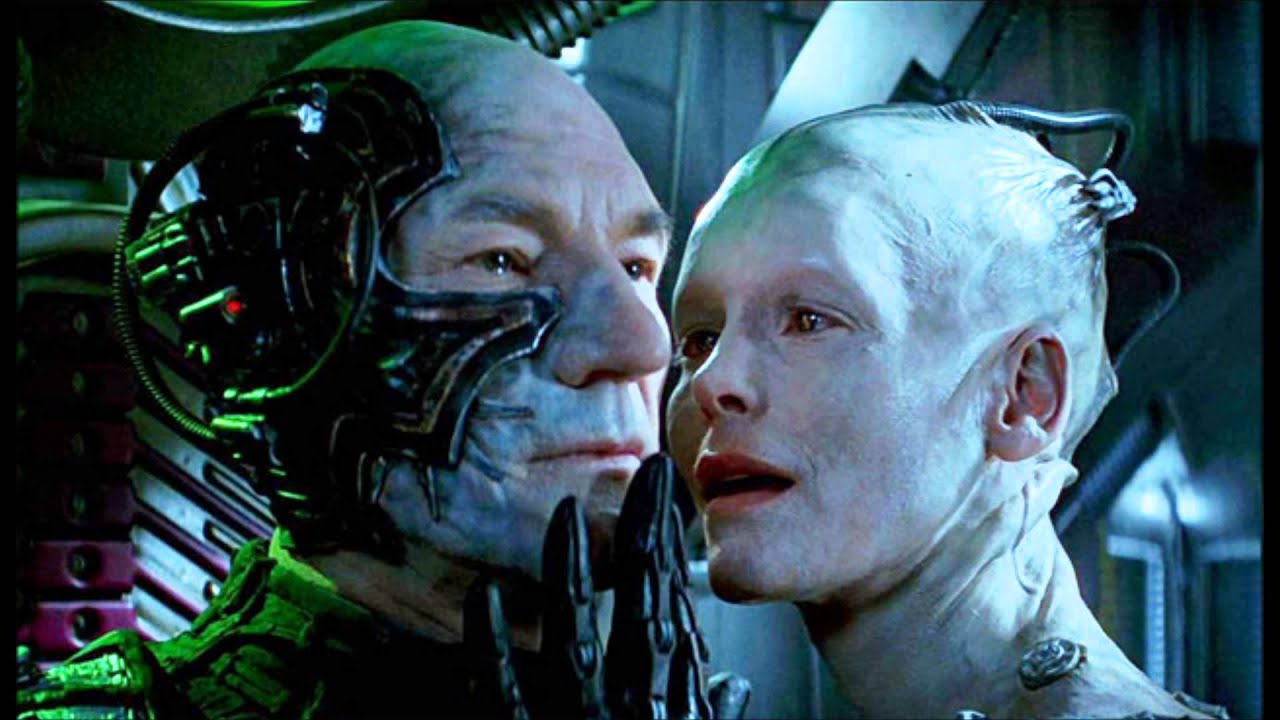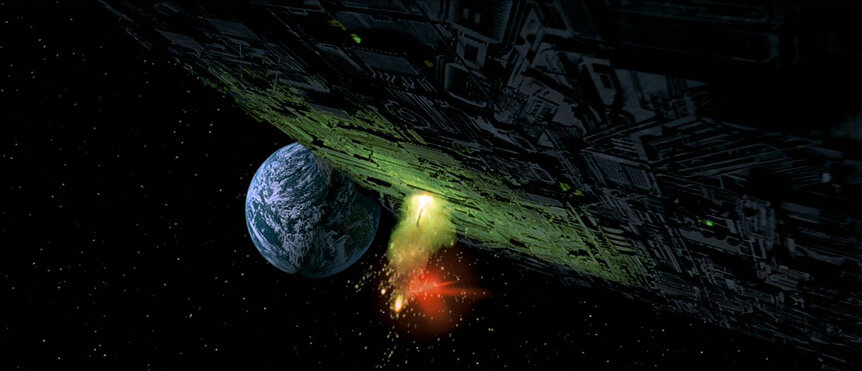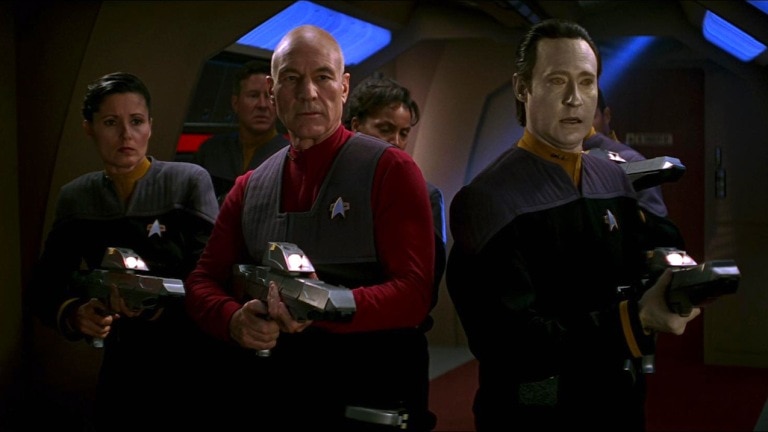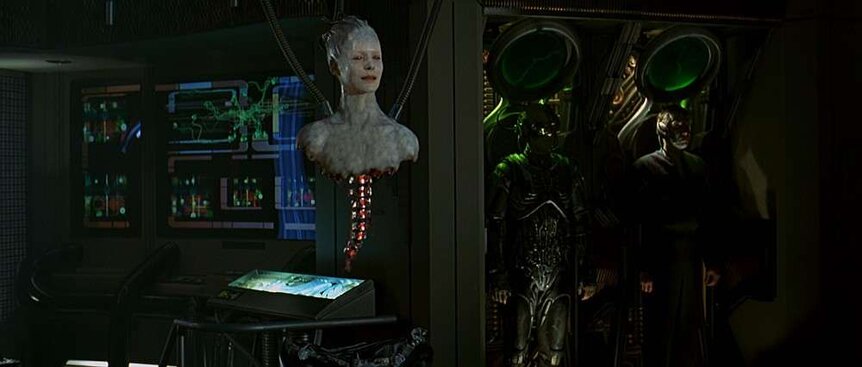Create a free profile to get unlimited access to exclusive videos, sweepstakes, and more!
'Star Trek: First Contact' at 25: Co-writer Ron Moore shares behind-the-scenes Borg secrets
Ron Moore reveals how they pulled off the Borg's first trip to the big screen.

A quarter-century ago, Star Trek: First Contact was a big deal.
Released on Nov. 22, 1996, the second big-screen adventure featuring the Star Trek: The Next Generation crew — and the first (and only) movie with the Borg — surpassed Paramount Pictures' already-high expectations to become only the second Trek film to ever achieve crossover appeal at the box office, racking in over $90 million domestic. (The first film to tractor beam in more than the core Trek fanbase was 1986's Star Trek IV: The Voyage Home).
Fan expectations were extremely high as well. First Contact, a sequel to both 1994's Star Trek: Generations and the iconic TNG Season 3 cliffhanger, "The Best of Both Worlds," features a riveting, character-first "upstairs, downstairs" storyline where, after the Borg threaten to assimilate Earth in the past, Captain Picard (Patrick Stewart) is forced to go back in time, battle the Borg and grapple with the trauma he suffered years ago on the TV series when the race of cybernetic beings assimilated him into their soulless collective. In between phaser fights with the Borg, Picard struggles with a bourgeoning vendetta that is at odds with his "more evolved" Starfleet sensibilities, a topic which sparks a few compelling dramatic beats between the good captain and a stowaway aboard the new Enterprise-E, Lilly (the great Alfre Woodard). Lilly hails from a post-WWIII Earth, in Montana, where she was working with the creator of warp drive, the brilliant (but drunk) Zefram Cochrane, played by James Cromwell. In this movie, Picard and crew are essentially fighting to save Star Trek, because if the Borg succeed in their mission, then Trek will cease to exist.
As smooth and effortless as the action above plays out on screen, First Contact wasn't without a few Red Alerts behind the scenes. To celebrate the film's 25th anniversary, co-writer Ronald D. Moore gave SYFY WIRE an exclusive interview where he revealed how he, his then-writing partner Brannon Braga, and executive producer Rick Berman pulled off one of the best Trek movies ever.
In an early draft, fans know that it was originally Riker on the Enterprise-E, fighting the Borg, with Picard planet-side. How long into the process before you and Brannon realized you have to flip that?
We did at least a draft or two of that version, and I know Patrick wanted to be on the ship. Patrick had really liked doing the [TNG episode] "Starship Mine", where he was alone on the Enterprise-D and running around. And I think he overtly referenced that in a way like, “I would really like to be the one on the ship fighting the Borg, instead of down on the surface.” And Rick Berman relayed that to us and I think Brannon and I just immediately went: “Yeah, actually that that's better. That makes more sense.” And even though the biggest stakes were happening “downstairs” on the planet, dramatically speaking, you just felt like the real drama, the real action, was “upstairs” on the ship. So it made sense to just flip that.
And how far did you go in the process of drafting or outlining where the crew originally went back to Renaissance or medieval times?
We discussed it. I don't think we ever did a draft of that. I think there was an early stage of conversations with Rick where we were talking about various periods of time and I think the Renaissance got brought up. Maybe we dashed off a story outline, or at least as a concept page or something about it, but it never got very far.
One of the best battles Trek has ever done is the one between the Borg cube and the entire fleet that opens this movie. But, it feels like the filmmakers wanted to go much bigger.
Oh yeah. We kept having to cut down. I couldn't tell you what it was [exactly], but everything was broken down into discreet shots and sequences. We had, first, the big battle, then the Enterprise coming in, and then there were all these descriptions of this starship comes over and does this, and it takes that kind of hit and then this ship spins. And so there was a lot of just bells and whistles to it. Over the course of production, you're just cutting and cutting and consolidating and begging and trying to scrape together money. Arguing why this one shot is the most important, or more important than this other one over here. And you do that just with everything, especially at that stage with the state of technology and CG at the time, it wasn’t really a cheap conversation.
You have this tedious exercise in the production meeting where you are literally counting the shots: How many shots can work, how many can you shoot [onscreen], and how many times do you have to get, you know, “Data’s going to fire from off-camera” to save the production some cash. We had those on the show, too, a lot. And here, it was so excruciating because — you kind of felt that, once [TNG] got into the features, they were going to give us a bucket of money and we were not going to have those kind of conversations anymore. And we did end up have those same conversations, it was just, you added a zero to all the dollar figures because everything costs more at the feature level.
Wow.
It was a constant source of frustration because the budgets were not huge, not like, you know, the $100 million budgets that the more recent movies have had. It was a fairly limited budget for a feature film at that point.
So even after the success of Star Trek: Generations, the studio still nickel-and-dimed you.
Paramount's position at the time was: “A Star Trek movie will make this amount of money. Therefore, we will give you this amount of money, so that we have this amount of profit. And it was very much a formula. I'm trying to even grasp it. I think it was like $75 million or something, including marketing. That’s the budget. Period. End of story. Because these films don’t earn more than this [amount], and the studio doesn’t want to earn less that. So the studio is like: “We shoved it through our system, there’s your budget, be on your way.” And that was it.
You and Brannon had some mile markers to hit when you wrote Generations, story items that the studio insisted on. Did they have similar mandates this time around?
It was pretty much carte blanche. The studio said: “Just go do it. Go do another one.” When Rick approached Brannon and I to write it, it was: “Hey, what do we want to do this time?” And I think Rick said: “I’d like to do a time travel piece. And maybe we should do something with the Borg.” I think those both came from him and then it was let's go make a story that encompasses those elements.
I know it’s been 25 years, but was there a scene or beat you wanted to squeeze in but was ultimately cut?
There were just expanded sequences. There was just more action in general, more fighting the Borg in the corridors, and going into different places on the ship. And I think there was more humor. A lot of the jokes got cut down. I think we had more fun with Troi (Marina Sirtis) and Cochran’s relationship on Earth, where he gets her drunk. We had more to that sequence scripted and that was fun to write, too. Rick might have made us cut it because he was always a little too — he was always kind of worried that maybe the humor would be too corny or something.
I read in an early draft a scene where Picard and Lilly are forced into a turboshaft to escape the Borg, and the shaft is so big, it has its own weather system —
Oh, wow, yeah, I do remember that.
And they somehow harness some lightning, some static electricity, to zap the Borg.
That was inspired by something I had read about the NASA vertical assembly building, which is this massive block where they assembled the Saturn V rocket. And the interior space of that complex was so big, that it literally had its own weather system at the top. Like it would have its own moisture and would kind of rain in there. And I remember reading that and it stuck with me for years. [Editor’s note: Moore first tried to find a home for this scene in the TNG episode, “Disaster,” where Picard is trapped in another turboshaft with children.] I was always fascinated by that concept. And I always wanted to do something like that inside the Enterprise. It would have been great to do it for a movie, you’d think we would be able to, but…
They couldn’t give you the money to do that. It would have been a great scene.
That was all money. Well, we were told that anything with water, it costs a fortune. I remember we really wanted to do it because we thought that'd be pretty cool. You hadn't seen it rain inside of a starship, and that setting is kind of interesting with the lightning and all that. But, yeah, it just got cut.
The movie famously introduces the Borg Queen into the canon. Was that something you had in mind from the jump?
It came out of the development process and we wrestled with it quite a bit before we committed to her character. Because it was a choice that was also antithetical to the idea of the Borg. The whole concept of these villains was that they were a collection, and that there were no individuals. And that's what made them the faceless, implacable “resistance is futile” enemy. But it also limited how to deal with them dramatically because it meant that any scenes you always had to deal with this sort of collective voice, and you never had or saw a character to play to. And as soon as you bring the Queen into it, that voice became an individual and it brought up significant, in-world story questions. So we really went back and forth about it internally; the three of us argued it every which way. We decided that the story would be better if we had some individual to deal with. To craft scenes around, to do an intimate kind of dialogue back and forth and help get inside characters’ heads — like Data in particular, and Picard.
So what we came up with was, there this idea of a Borg Queen that controlled at least this collective of that particular ship, not necessarily that she was the queen of the whole Borg. We wrestled with it for quite awhile before deciding to do it.
And who came up with her iconic entrance?
That might've been Rick? I can remember him describing that, I think it was either him or Brannon. It wasn’t me, but I can kind of picture Rick in his office, getting very animated and talking about how her head would come down and it would link into this body.
How was your process developing the story and working with TNG actor-turned-director Jonathan Frakes, on his feature debut?
It was fun. We had done it before, on the show, so we had a good shorthand with Jonathan and a good working relationship. He totally understood the characters and the franchise and had gone through the process of making a movie [Generations] once before with another director and he knew us and how we had written for him. So it was great. It was a a very smooth relationship.





























